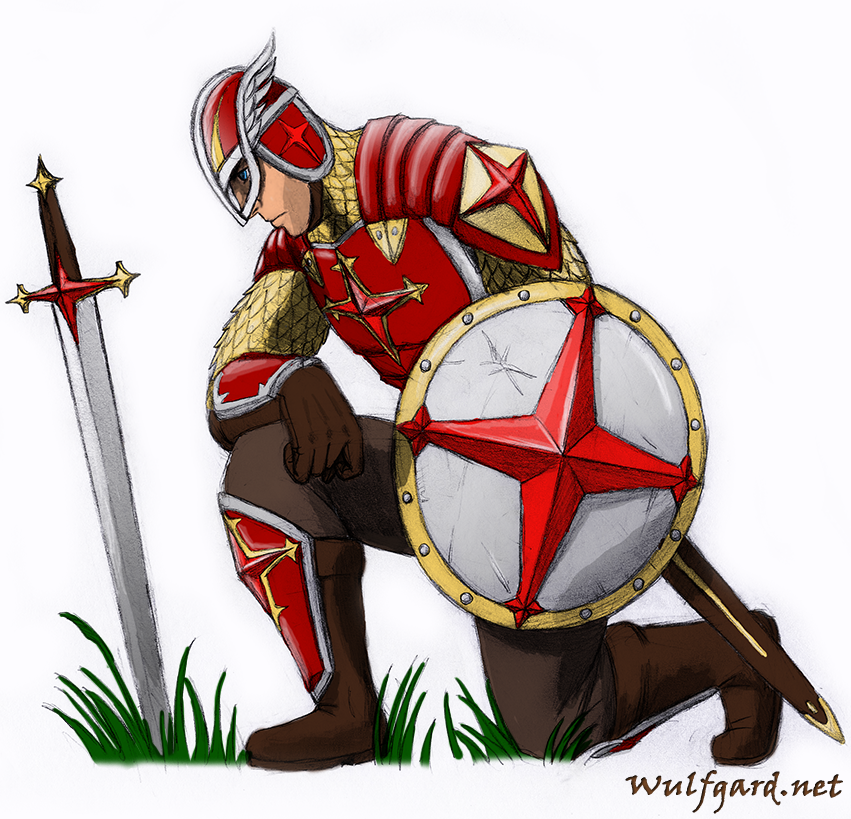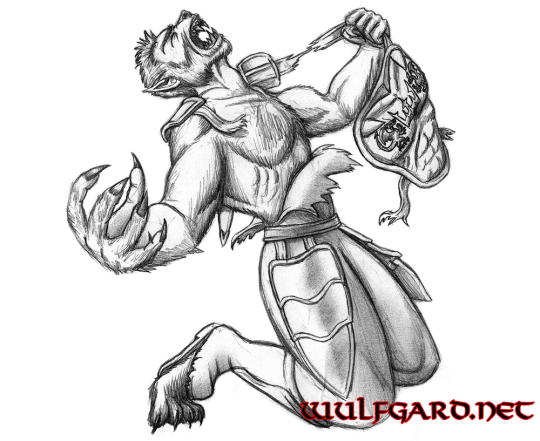Werewolves as Noble Knights
Here’s something very near and dear to my heart – the medieval werewolf knight.

There were actually lots and lots of werewolf knights in medieval folklore and stories. They were noble, kind, gentle (when they wanted to be, of course – or they could be ferocious and kick your ass, if you were evil), and completely in control of themselves. They were chivalrous and a shining example of what a courtly knight should be, no matter what form they happened to be in at the time.
Some of the more prominent of these werewolf knight stories include Bisclavret, Melion, Arthur and Gorlagon, and Guillaume de Palerne. And Bisclarel, which is essentially a retelling is Bisclavret by a slightly different name. I’ll cover each in brief.
Interested in some time periods on these, just for authenticity? Bisclavret came around during the early or mid twelfth century, Melion from around 1190-1204, Bisclarel from around 1319-1342, Arthur and Gorlagon from the fourteenth century, and Guillaume de Palerne from around 1220. This means that Bisclavret would have been written around the very same time as King Cnut provided us with the first recorded use of the word “werewolf.” So one of the first ever uses of the word “werewolf” was to refer to a noble werewolf knight!
That being the case, let’s start off with what might be my very favorite werewolf story: Bisclavret, also called the Lai of the Werewolf, by Marie de France.
There’s a lot I could say about this, but for the time being, let’s keep it simple. In the lai of the werewolf, we meet a noble knight whose wife asks him why he disappears so often and for so long. The knight, after some persuading, admits to his wife that he is a werewolf who lives under the following conditions: he goes to the woods, removes his clothes, and hides them. He must return to his clothes and put them on in order to reassume his human form. And if he can’t get his clothes back, he also remains in wolf form forever.
So the wife steals the knight’s clothes and hides them so he cannot turn human again, because she finds this whole werewolf thing terrible and gross. The werewolf knight finds his king and bows to him, making obeisance like a human. Surprised and moved, the king takes pity on the wolf, taking it into his court. The werewolf becomes his loyalest companion.
Until one day the werewolf’s wife comes into court. The werewolf leaps at her and attacks (in some version he bites her nose off, which is medieval symbolism I won’t delve into here, but I could, if you’re curious), alarming the entire court. The king knows something is up, so he interrogates the wife, who admits everything. The king has the werewolf knight’s clothes returned, gives him privacy to put them on and become human again, and rejoices the return of one of his best knights.
That’s it. No punishment for being a werewolf. No negativity about that aside from the wife’s actions.
You can actually read all of Bisclavret online for free, through Project Gutenberg. It’s kind of a funny translation of it, but it gets it done. Here it is, for those interested. (Marie de France’s other lais are quite good, too!) It’s a wonderful little story.
Melion is very similar in story to Bisclavret. It’s about a knight of King Arthur’s court, but in this instance, it involves the knight using a magic ring to turn into a wolf and catch a particular deer that his (crazy) wife wanted so bad she said she’d die if she didn’t eat the venison. Turns out she just wanted to cheat on him, so she steals all his clothes he needs to turn back and elopes with a squire. Melion isn’t nearly as nice a wolf as Bisclavret, and he takes to banding with other wolves and killing livestock and people. Eventually, King Arthur comes and Melion bows to him like Bisclavret did to his king, and the story repeats itself: he sees his treacherous wife in court later, attacks her, surprises everyone, etc. (Bisclavret is a better story for all sorts of reasons, I mean – not that I’m biased)
The tale repeats itself yet again in Arthur and Gorlagon, in which we get an angsty King Arthur coming to Gorlagon in an attempt to “understand women.” Gorlagon tells him a tale very much like Bisclavret, and then admits he is the werewolf in the story.
Next up is Guillaume de Palerne. This is a story that includes a character named Alfonoso, a Spanish prince and cousin to the protagonist Guillaume, who was turned into a wolf by – basically – his evil stepmother. Alfonso provides food and protection for our young fugitive protagonist, who eventually wins back his kingdom and turns Alfonso back into a human.
There’s also mention of werewolf knights in Sir Thomas Malory’s Le Morte d’Arthur, written in 1470. Specifically, we hear mention of a Sir Marrok – “Sir Marrok, the good knight that was betrayed with his wyf, for she made hym seven yere a wer-wolf.” And that’s really all we get about him in that particular story, though scholars have worked hard to dig up more about him and some of them have (sort of?) succeeded. But, in short, it’s another story in the vein of Bisclavret.
Except Bisclavret is clearly the best, because being a werewolf was a permanent condition for that knight, so he was a noble werewolf for the rest of his days. Whereas these other losers get turned back into humans forever.
So now you know that about me: werewolf knights are one of my absolute favorite tropes no one actually knows about or uses anymore, because it’s literally a medieval trope.

But I have werewolf knights. Over at Wulfgard, my medieval fantasy setting, which I am now shamelessly telling you about because one of my novels, Knightfall, is the first installment in a series about – you guessed it – a werewolf knight.
So now you know that werewolf knights were a thing long before all these crazy evil mad werewolves were. Those werewolf knights would’ve gladly saved your life, guarded you, brought you food… They were really great. They weren’t the only nice/benevolent medieval werewolves, either.